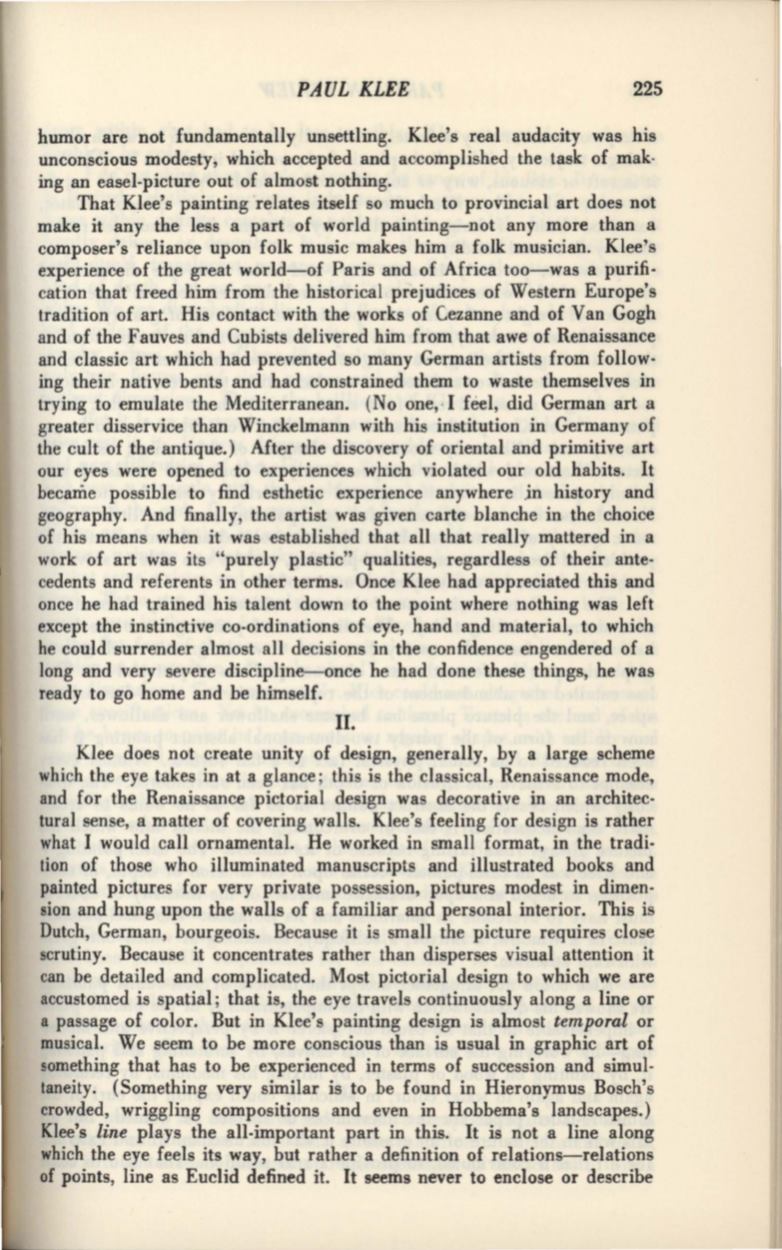
PAUL KLEE
225
humor are not fundamentally unsettling. Klee's real audacity was his
unconscious modesty, which accepted and accomplished the task of mak
ing an easel-picture out of almost nothing.
That KJee's painting relates itself so much to provincial art does not
make it any the less a part of world painting-not any more than a
composer's reliance upon folk music makes him a folk musician. Klee's
experience of the great world-of Paris and of Africa too-was a purifi–
cation that freed him from the historical prejudices of Western Europe's
tradition of art. His contact with the works of Cezanne and of Van Gogh
and of the Fauves and Cubists delivered him from that awe of Renaissance
and classic art which had prevented so many German artists from follow–
ing their native bents and had constrained them to waste themselves in
trying to emulate the Mediterranean. (No one, ·I feel, did German art a
greater disservice than Winckelmann with his institution in Germany of
the cult of the antique.) After the discovery of oriental and primitive art
our eyes were opened to experiences which violated our old habits. It
became possible to find esthetic experience anywhere jn history and
geography. And finally, the artist was given carte blanche in the choice
of his means when it was established that all that really mattered in a
work of art was its "purely plastic" qualities, regardless of their ante–
cedents and referents in other terins. Once Klee had appreciated this and
once he had trained his talent down to the point where nothing was left
except the instinctive co·ordinations of eye, hand and material, to which
he could surrender almost all decisions in the confidence engendered of a
long and very severe discipline-once he had done these things, he was
ready to go home and be himself.
II.
Klee does not create unity of design, generally, by a large scheme
which the eye takes in at a glance; this is the classical, Renaissance mode,
and for the Renaissance pictorial design was decorative in an architec–
tural sense, a matter of covering walls. Klee's feeling for design is rather
what I would call ornamental. He worked in small format, in the tradi–
tion of those who illuminated manuscripts and illustrated books and
painted pictures for very private possession, pictures modest in dimen–
sion and hung upon the walls of a familiar and personal interior. This is
Dutch, German, bourgeois. Because it is small the picture requires close
scrutiny. Because it concentrates rather than disperses visual attention it
can be detailed and complicated. Most pictorial design to which we are
accustomed is spatial; that is, the eye travels continuously along a line or
a passage of color. But in Klee's painting design is almost
temporal
or
musical. We seem to be more conscious than is usual in graphic art of
something that has to be experienced in terms of succession and simul–
taneity. (Something very similar is to be found in Hieronymus Bosch's
crowded, wriggling compositions and even in Hobbema's landscapes.)
Klee's
line
plays the all-important part in this. It is not a line along
which the eye feels its way, but rather a definition of relations-relations
of points, line as Euclid defined it. It seems never to enclose or describe


